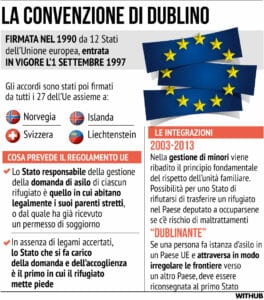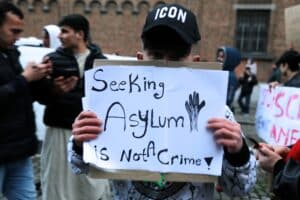Brussels – The Migration and Asylum Pact overcomes the last potential stumbling block on which it could have stalled on the last stretch of the legislative process. Less than two months after the interim political understanding with the European Parliament, the Committee of Permanent Representatives (COREPER) gave the green light today (Feb. 8) to all files of the new EU legislation, with a few changes from the original ones: “After examining the 10 texts of the Migration and Asylum Pact, the EU ambassadors decided to send the final compromise to the European Parliament in order to move torwards the final approval,” has announced the Belgian rotating presidency of the EU Council.
 The understanding among the twenty-seven countries eliminates the last risks of opposition from individual governments on some of the most contentious points of the new Migration and Asylum Pact, including the merger of the Regulation on Instrumentalisation with the Regulation on Crisis and Force Majeure and the Regulations defining the principles of responsibility and solidarity in the management of migrants. After discussing the last technical details, the legal services had to create separate files “because of the variable geometry of the Pact” and the need to bring “all elements of Schengen into a separate Regulation,” sources close to the files say. The new introductions concern two duplications of as many Regulations: an amendment of the Regulation to facilitate screening (in addition to the Screening Regulation) and a Regulation establishing a border return procedure (in addition to the Regulation on asylum procedures).
The understanding among the twenty-seven countries eliminates the last risks of opposition from individual governments on some of the most contentious points of the new Migration and Asylum Pact, including the merger of the Regulation on Instrumentalisation with the Regulation on Crisis and Force Majeure and the Regulations defining the principles of responsibility and solidarity in the management of migrants. After discussing the last technical details, the legal services had to create separate files “because of the variable geometry of the Pact” and the need to bring “all elements of Schengen into a separate Regulation,” sources close to the files say. The new introductions concern two duplications of as many Regulations: an amendment of the Regulation to facilitate screening (in addition to the Screening Regulation) and a Regulation establishing a border return procedure (in addition to the Regulation on asylum procedures).
Final steps in the European Parliament are now expected. Also according to sources, the vote in the Committee on Civil Liberties, Justice and Home Affairs (LIBE) is expected to be scheduled for next Thursday (Feb. 15), while the final stage in the plenary is expected in the first session in April (between the 10th and 11th), although some groups are reportedly seeking to bring it forward to the March session. “I welcome the decision of the member states to approve the Migration and Asylum Pact as agreed with the European Parliament,” rejoiced the President of the Parliament, Roberta Metsola, recalling that “this is an important step forward in defining new rules on how Europe handles migration and asylum, ahead of the European elections in June.”
The basis of the Migration and Asylum Pact
The basis on which the new Migration and Asylum Pact system is set is the relationship between solidarity and responsibility in the management of migrants among the 27 countries. The former concept permeates the Regulation for the Management of Asylum and Migration (RAMM), which in no way overrides the cardinal principle of the 2013 Dublin Regulation, namely that the task of examining the asylum claim of a person who enters the EU territory irregularly lies with the first EU member state to which he or she enters. Countries such as Italy, Greece, Malta, Cyprus, and Spain will be responsible for applications, while other member states that want to “dublin” (i.e., extradite) these migrants (including minors and those applying for reunification with siblings) will simply have to send a notification, no longer a reciprocal process request with the agreement of the country of first arrival as is the case today. After the Regulation enters into force—24 months after its publication in the EU Official Journal—the now famous mandatory solidarity mechanism for all 27 countries (based on GDP and population) will be introduced, which equalizes three forms of solidarity: relocations of migrants, financial contributions, or support to third countries. Contributions to member countries can be directed not only to reception systems but also to the funding of fixed and mobile border facilities through the Border and Visa Management Instrument (BMVI) and the Asylum, Migration and Integration Fund (AMIF). No mandatory relocation for migrants disembarked after search and rescue operations at sea and for those under the RAMM procedure, there is no legal representation, only counselling.
 The concept of accountability is particularly related to the Asylum Procedures Regulation (APR), which increases only those provided for countries of first entry. It will automatically apply if there is a risk for security threat issues (including unaccompanied minors), of “deception of authorities”, or if the migrant person comes from a country with a recognition rate of less than 20 per cent. Border procedures will provide de facto detention, with no exemptions even for families with children under 12, nor legal representation, nor a stay for appeals against most decisions (the exception is for inadmissibility of those based on the concept of “safe third country” and for unaccompanied minors). Crucial to this Regulation is precisely the “Safe Third Country” concept, for which both an EU list and national lists are provided to justify and expedite rapid returns out of the Union unless there are links of the person to the state in question that preclude their safety. New accountability obligations include completing the examination of an asylum application through the border procedure within six months (APR), but also extending the period of responsibility for handling applications for 20 months and maintaining at 12 months that for search and rescue operations at sea (RAMM). The annual ceiling for border procedures is set at 30,000 people, determined on the basis of a formula that takes into account the number of irregular border crossings and the number of expulsions in the previous three years.
The concept of accountability is particularly related to the Asylum Procedures Regulation (APR), which increases only those provided for countries of first entry. It will automatically apply if there is a risk for security threat issues (including unaccompanied minors), of “deception of authorities”, or if the migrant person comes from a country with a recognition rate of less than 20 per cent. Border procedures will provide de facto detention, with no exemptions even for families with children under 12, nor legal representation, nor a stay for appeals against most decisions (the exception is for inadmissibility of those based on the concept of “safe third country” and for unaccompanied minors). Crucial to this Regulation is precisely the “Safe Third Country” concept, for which both an EU list and national lists are provided to justify and expedite rapid returns out of the Union unless there are links of the person to the state in question that preclude their safety. New accountability obligations include completing the examination of an asylum application through the border procedure within six months (APR), but also extending the period of responsibility for handling applications for 20 months and maintaining at 12 months that for search and rescue operations at sea (RAMM). The annual ceiling for border procedures is set at 30,000 people, determined on the basis of a formula that takes into account the number of irregular border crossings and the number of expulsions in the previous three years.
What happens when migrant people arrive
Once migrants arrive at the Union’s borders, the Regulation on Screening of the Migration and Asylum Pact will provide a 7-day detention procedure for the division between regular (RAMM) or expedited (APR) procedures for processing their asylum claims. Since the so-called “fiction of non-entry” has remained (that is, that anyone who is screened in a special centre will not be considered legally on the territory of the member state and therefore of the EU) in fact, migrants will be detained, as they will have to remain at the disposal of the authorities without the possibility of entering the national territory. Some guarantees include the possibility for applicants to have access to a copy of the screening form and the preservation of the “relevant rules on detention” set out in the 2008 Return Directive (the revision contained in the Migration and Asylum Pact is the only dossier that is certain to fail). But the monitoring mechanism (which does not necessarily include NGOs, but can do so at the discretion of states) does not apply to border surveillance activities (with a normalization of racial profiling) and if the state recognizes a security threat it will be able to grant national authorities direct access to all data on the person in all databases.

Concerning databases, according to the Eurodac Regulation all migrant persons benefiting from temporary protection from the age of 6 will have to accept the collection of their biometric data, even though under the General Data Protection Regulation (GDPR) processing is lawful only if the minor is at least 16 years old. Included in the expansion of data access for national authorities is the collection of photographic data of faces, effectively giving the green light to mass surveillance of people arriving on EU territory. Security alerts to be entered into the Eurodac database during the screening process and border procedures will include a whole range of new categories (such as irregular border crossing) also through the revision of the Entry and Exit System Review Regulation.
What happens in a crisis
One of the most controversial items in the Migration and Asylum Pact is the Regulation for Crises, Instrumentalisation and Force Majeure, which deals with times when there is an exceptional or unexpected “mass arrival of people,” including following disembarkation after a search and rescue operation at sea. The council’s negotiating position passed, which led to the inclusion of instrumentalisation (a Regulation that was initially a stand-alone and on which Parliament had not given the OK) in that for crises and force majeure, in cases where “a hostile third country or non-state actor encourages or facilitates the movement of third-country nationals and stateless persons” towards the EU external borders “with the aim of destabilizing the Union or a Member State” by putting “the essential functions of a Member State at risk.” NGOs are excluded from this definition, but, in fact, only if they can demonstrate that their actions (at sea and otherwise) are not intended to destabilize, with clear risks of repercussions for the criminalization of solidarity.
 Not even in crises there are mandatory relocations of migrants between member countries, but the same three modes of solidarity as in the RAMM Regulation (relocations, financial contributions or support to third countries) will apply. Instead, derogations to the overall migration and asylum management system are triggered in this scenario: the recognition rate threshold for which people can be admitted to border procedures (under the APR Regulation at 20 per cent) is raised to 50 per cent in force majeure situations, 60/70 per cent in crises, and 100 per cent in instrumentalisation situations. Again, from the border procedures, whose duration can be extended by an additional six weeks (compared to the 9 months in APR), families with children under the age of 12 are not excluded.
Not even in crises there are mandatory relocations of migrants between member countries, but the same three modes of solidarity as in the RAMM Regulation (relocations, financial contributions or support to third countries) will apply. Instead, derogations to the overall migration and asylum management system are triggered in this scenario: the recognition rate threshold for which people can be admitted to border procedures (under the APR Regulation at 20 per cent) is raised to 50 per cent in force majeure situations, 60/70 per cent in crises, and 100 per cent in instrumentalisation situations. Again, from the border procedures, whose duration can be extended by an additional six weeks (compared to the 9 months in APR), families with children under the age of 12 are not excluded.







